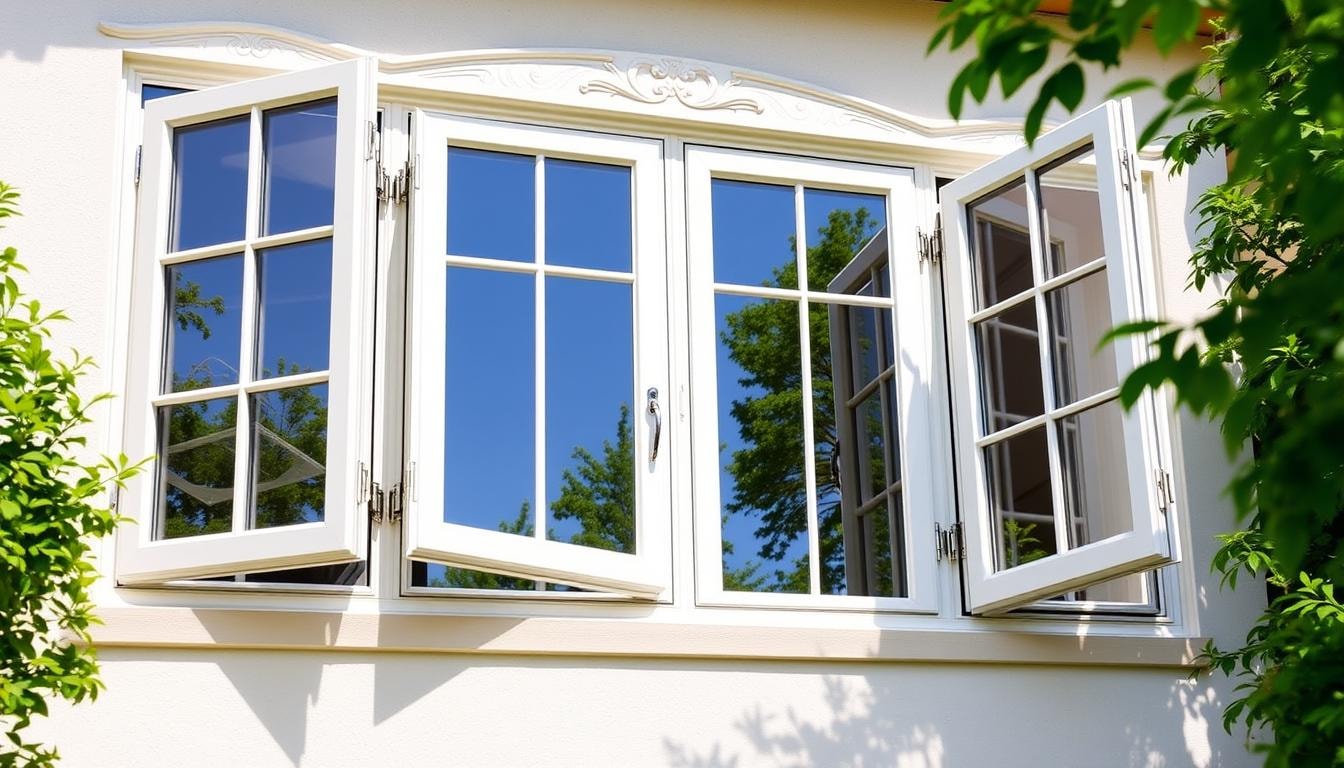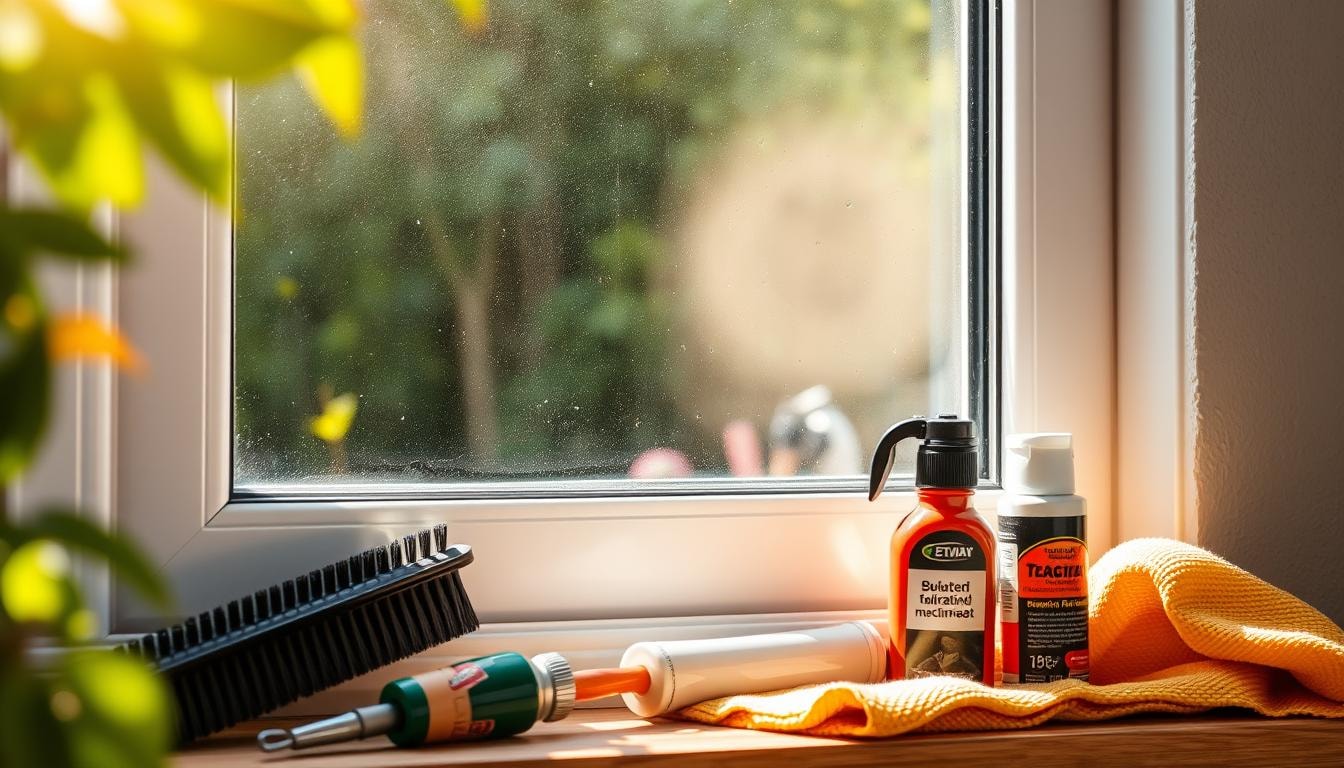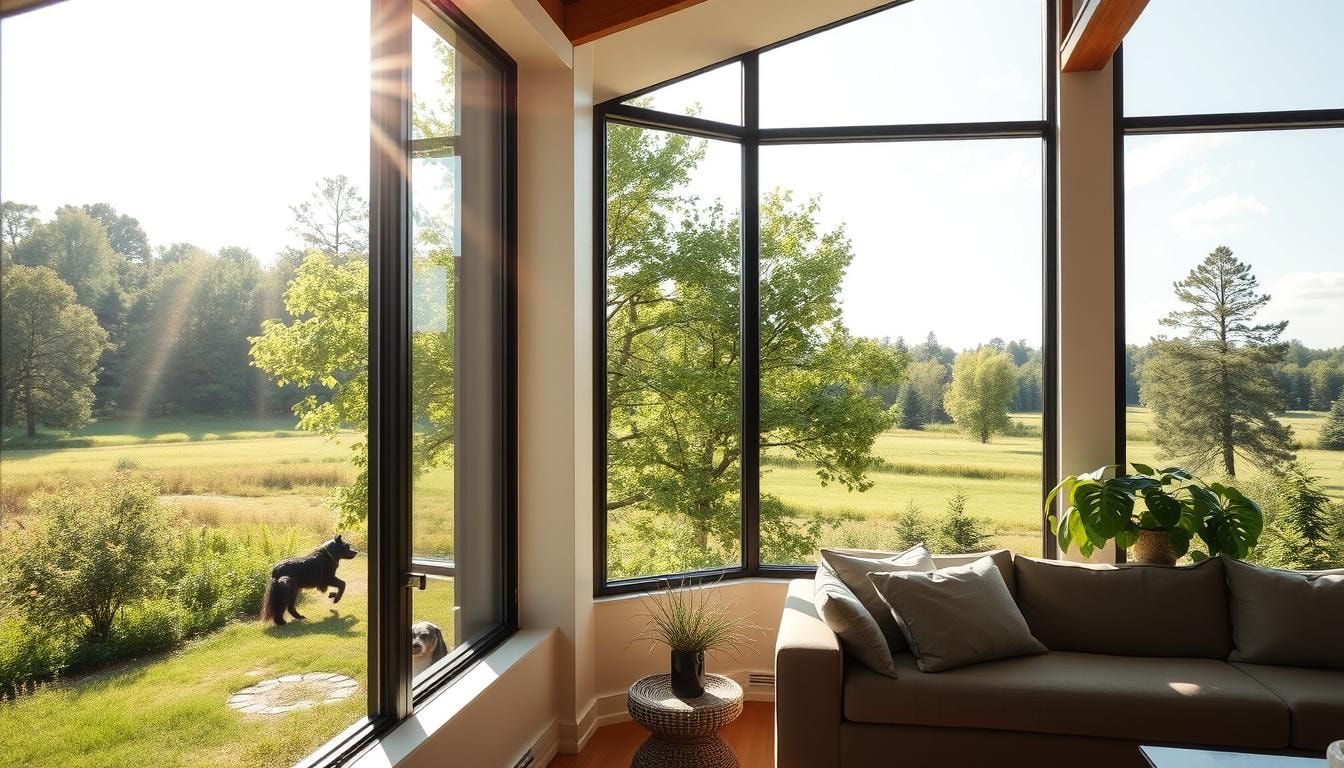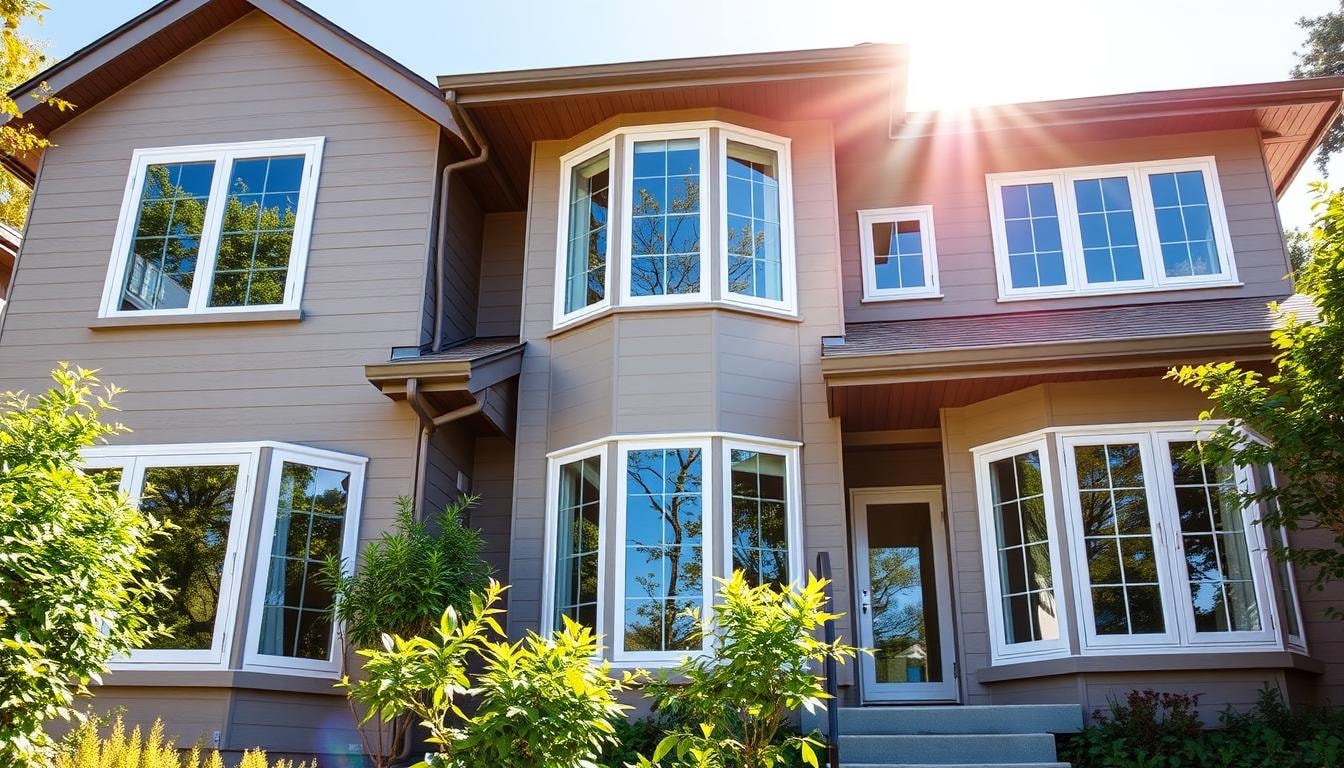
Casement Window Specifications: A Complete Overview
Casement windows are a classic choice for homes. They are durable, energy-efficient, and stylish. These windows swing open, giving great ventilation and views.
They can be opened by hand or with a special crank. This makes them fit many home styles.
Casement windows seal tightly, which helps keep your home warm or cool. They come in single, double, or combo styles. This lets homeowners choose between looks and function.
Whether you’re building or updating, casement windows are a smart pick. They make your home look better and save energy.
Key Takeaways
- Casement windows are versatile and suitable for various home styles.
- They offer high energy efficiency when properly installed.
- Casement windows can be configured in different ways to suit your needs.
- Various frame materials are available, each with their own pros and cons.
- Casement windows provide excellent ventilation and energy efficiency compared to other window types.
Casement Windows: Basic Components and Design
Casement window frames are made with a jamb thickness of about 1 7/64 inches (28 mm) for the sides. The sill, or bottom part, is around 1 9/16 inches (40 mm). The sash, which holds the glass, is 2 3/16 inches (56 mm) thick.
Window Frame Construction
Casement windows are great for rooms needing good airflow. Their side-hinged design lets the sash swing outward. This opens up to 90 degrees for better air and access.
Sash Components and Design
The sash of a casement window holds the glass. It’s made to press against the frame, keeping out drafts and heat. This makes casement windows energy-efficient.
Operating Mechanisms
Casement windows open outward, improving air flow. The crank or lever makes opening and closing easy. This makes casement windows convenient and functional for homeowners.
Material Options for Casement Windows
Casement windows are made from different materials. Each has its own benefits. Homeowners can pick from vinyl, wood, and more for their homes.
Vinyl windows are affordable and easy to care for. They are weather-resistant and come in a few colors. But, they are great at keeping your home warm or cool.
Wood frames add a classic look, especially for old homes. Wood keeps your home warm but needs regular care to look good.
Aluminum frames are modern and strong. They are good for new homes but don’t keep your home as warm as vinyl or wood.
Composite windows mix wood and metal or vinyl. They are warm, last long, and don’t need much care. This makes them popular with many homeowners.
All casement windows are good at keeping your home warm or cool. They seal well to stop drafts. Their design also lets in lots of air, perfect for busy rooms.
Standard Measurements and Tolerances
Standard sizes and tolerances are key for casement windows. They ensure the windows fit right and work well. The width starts at 16 inches and goes up in 4-inch steps to 48 inches. Height ranges from 24 to 84 inches, with 12-inch steps.
The smallest size is 24 inches wide by 48 inches high. The biggest can be 96 inches wide and 72 inches high.
Frame Dimensions
Manufacturers use a four-digit code for sizes. The first two digits show the width in feet and inches. The last two digits show the height in feet and inches. This makes it easy to pick the right size.
Sash Specifications
The sash specs are also important. They consider glass thickness, hardware clearances, and sash shape. This ensures the sash fits well with the frame.
Installation Clearances
Casement windows have special clearances for installation. These account for wall thickness, framing, and space for operation. This makes installation smooth and secure.
While standard sizes are handy, custom sizes are also available. They fit unique designs or special needs. Working with manufacturers or installers ensures the best fit for your project.
Glazing Options and Energy Efficiency Features
Casement windows come with different glazing options to save energy. Double-pane and triple-pane glass are common. Triple-pane glass is better at keeping warm in.
Low-E coatings on the glass help keep heat out and protect from UV rays. Gas fills like argon or krypton also help keep the windows warm or cool.
The U-factor shows how well a window keeps heat in. Lower U-factors mean better insulation. This can lower your heating and cooling costs.
Energy-efficient casement windows can save you money. They also help the environment by using less energy.
- Triple-pane glass windows are recognized as ENERGY STAR® Most Efficient and certified to meet the rigorous level of energy efficiency required by Phius (Passive House Institute US).
- Dual-pane glass is a standard option on all windows and required by most building codes, while triple-pane glass is an option on A-Series and E-Series windows.
- Triple-pane glass has an additional air space and third sheet of glass added, making it the most energy-efficient glass type.
Casement windows also have special energy-saving features. For example, SmartSun™ glass blocks 95% of harmful UV rays. It’s good for both hot and cold places.
PassiveSun® glass is for places that need a lot of heat. HeatLock® technology keeps warmth in for the coldest places.
The solar heat gain coefficient (SHGC) is key. It shows how much heat comes in through the windows. Lower SHGC values mean less heat, which saves energy.
Choosing the right glazing and features can make your home more comfortable and cheaper to run.
Weather Stripping and Sealing Systems
Casement windows have great weather stripping and sealing systems. They help keep your home warm and dry. These systems make sure your windows work well for a long time.
Compression Gasket Types
Compression gaskets seal the window tight when it’s closed. They’re made of flexible stuff like EPDM rubber or silicone. These gaskets squeeze to block air and water.
Secondary Sealing Methods
Casement windows also use extra sealing methods. Foam-filled channels or brush seals add extra protection. They help keep your home safe from the outside.
Performance Requirements
The quality of these systems is checked by air and water standards. These standards make sure your windows are energy-efficient and weather-resistant. They keep your home comfortable and safe from the weather.
Keeping your window frame in good shape is key. Replacing weather stripping on time keeps your windows efficient. A tight seal makes your home cozy, saves energy, and makes your windows last longer.
Hardware and Operating Mechanisms
Casement windows have special parts that make them easy to use and safe to close. The main parts are hinges, handles, and locks. They open outwards, giving great air flow and a clear view.
They use multi-point locks for a tight seal and more security. Crank operators are common, making it easy to open and close the window. Some casement windows even have motorized operators for extra convenience.
- Hinges: The hinges on casement windows are made of durable materials like stainless steel or brass.
- Handles: The handles are easy to hold and operate, with a classic design that looks good.
- Locking Systems: Casement windows use multi-point locks for a secure and weather-tight seal.
When picking hardware and mechanisms for your casement windows, think about how well they work, last long, are safe, and look good. This ensures a smooth and lasting experience.

Performance Ratings and Testing Standards
Casement windows are tested hard to make sure they meet high standards. They check how well they keep energy in, how strong they are, and if they keep air and water out. Companies like Andersen® and Western Window Systems test their windows well to show how they perform.
Energy Performance Metrics
How well casement windows keep energy in is checked in a few ways. These include U-factor, Solar Heat Gain Coefficient (SHGC), and Visible Transmittance (VT). The National Fenestration Rating Council (NFRC) gives ratings for these, with U-factor from 0.30 to 0.50 and SHGC from 0.25 to 0.40. Visible transmittance is from 0 to 1, with lower numbers meaning better performance.
Structural Performance Tests
Casement windows also get tested for how well they handle wind and opening forces. These tests follow ASTM International standards. For example, Western Window Systems’ Series 7670 Casement Windows are rated CW-PG50. This shows they can handle a lot of structural load.
Air and Water Infiltration Standards
Keeping air and water out is key for casement windows. Air tests show how well they block air, with a max of 0.3. Water tests check if they can keep water out in different weather. Meeting these standards means the windows will work well for a long time.
Installation Requirements and Considerations
Installing casement windows right is key for their best performance and life span. The opening should be about 1/2 inch bigger than the window frame on all sides. This allows for the right shimming and insulation.
Installers must make sure the window is level, plumb, and square in the opening. It’s also important to use the right flashing and weatherproofing to keep water out.
The process includes fixing the window frame, adding insulation, and putting on trim inside and out. It’s important to follow local building codes and the maker’s rules. Getting a pro to install is a good idea. They know how to do it right and fast.
Before buying windows, measure the opening well. This ensures the casement windows fit right. Getting the measurements and checking the structure is key for a good fit and lasting windows.
After installation, follow the maker’s care tips for your casement windows. Clean them often, oil the hardware, and replace weather stripping when needed. This keeps your windows working great.
Maintenance and Care Specifications
Keeping your casement windows in good shape is key. It helps them work well and look great. By following some easy steps, you can make your windows last longer and stay energy-efficient.
Cleaning Guidelines
To clean your casement windows, mix mild soap with water. Don’t use harsh cleaners or chemicals. They can harm the glass and frame. Use a soft cloth or sponge to wipe the windows clean.
For a streak-free finish, dry the windows with a clean, lint-free cloth. This makes them shine.
Hardware Maintenance
Every year, oil the hinges and locks of your casement windows with silicone-based lubricant. This keeps them moving smoothly. It also stops them from getting stiff.
Check the hardware often for wear or damage. Fix any problems right away.
Weather Stripping Replacement
The weather stripping around your windows is important for keeping them energy-efficient. Check it often for cracks, gaps, or brittleness. Replace it if you find any damage.
Good weather stripping keeps the air out. This makes your windows work better and look nicer for a long time.

Contact Budget Windows for Expert Solutions!
At Budget Windows, we specialize in offering quality windows and doors that fit your home perfectly. Whether you’re exploring new designs or need guidance with your window buying process, our experts are here to help. Contact us today to discover the best casement window solutions that match your preferences, enhance your aesthetics, and provide energy-efficient results.
Conclusion
Casement windows are great because they are functional, energy-saving, and look good. They let in lots of air and give you a clear view. This makes them perfect for many home styles.
They can make your home more energy-efficient, comfortable, and valuable. You can pick from many materials, sizes, and designs. This lets homeowners find the best fit for their homes.
FAQs
What factors affect casement window size?
Casement window size can vary depending on your home’s needs, preferences, and intended use. The total width and height can differ, with measurements typically ranging from smaller options for bedrooms to larger sizes for more natural light.
How does the window buying process work?
The window buying process typically involves measuring the rough opening, reviewing design preferences, and choosing materials like fiberglass or vinyl. You’ll also need to explore different options based on aesthetics and functionality.
What is the significance of the rough opening in window installation?
The rough opening is essential to ensure that the window frame fits correctly. It typically needs to be slightly larger than the casement window size to allow space for insulation and the manufacturing process.
Why should I consider the weight of a casement window?
The weight of a casement window can affect the ease of operation and the materials needed for the frame. Heavier windows might require stronger hardware, which can impact the window buying process.
How do drawings and documents play a role in window installation?
Drawings and documents are vital to ensuring the casement window size, materials, and installation process match your exact preferences. They help confirm measurements and design before starting the installation.







